
Xerochrysum bracteatum, commonly known as the golden everlasting or strawflower, is a flowering plant in the family Asteraceae native to Australia. Described by Étienne Pierre Ventenat in 1803, it was known as Helichrysum bracteatum for many years before being transferred to a new genus Xerochrysum in 1990. It is an annual up to 1 m (3.3 ft) tall with green or grey leafy foliage. Golden yellow or white flower heads are produced from spring to autumn; their distinctive feature is the papery bracts that resemble petals. The species is widespread, growing in a variety of habitats across the country, from rainforest margins to deserts and subalpine areas. The golden everlasting serves as food for various larvae of lepidopterans, and adult butterflies, hoverflies, native bees, small beetles, and grasshoppers visit the flower heads.

Astereae is a tribe of plants in the family Asteraceae that includes annuals, biennials, perennials, subshrubs, shrubs, and trees. They are found primarily in temperate regions of the world. Plants within the tribe are present nearly worldwide divided into over 250 genera and more than 3,100 species, making it the second-largest tribe in the family behind Senecioneae.
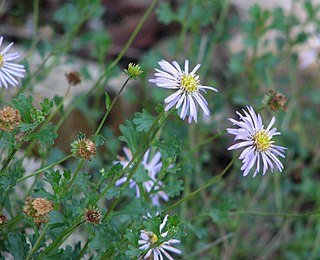
Calotis is a genus of herbs or small shrubs in the daisy family Asteraceae. Most of the species are native to Australia, while two occur in Asia.

Carpobrotus glaucescens, commonly known as pigface or iceplant, is a species of flowering plant in the family Aizoaceae and is endemic to eastern Australia. It is a succulent, prostrate plant with stems up to 2 m long, glaucous leaves, daisy-like flowers with 100 to 150 light purple to deep pinkish-purple, petal-like staminodes and red to purple fruit. The fruits ripen mainly in Summer and Autumn. It usually only grows very close to the sea.

Olearia phlogopappa commonly known as the dusty daisy-bush or alpine daisy-bush is a species of flowering plant in the family Asteraceae that is commonly found in eastern New South Wales, Victoria and Tasmania. It is a small shrub with greyish-green foliage, daisy-like flowers in white, pink or mauve that can be seen from spring to late summer.
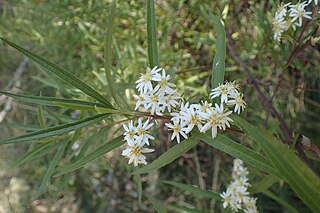
Olearia viscidula, commonly known as the viscid daisy bush or wallaby weed, is a species of flowering plant in the family Asteraceae and is endemic to eastern New South Wales. It is a shrub with scattered narrow elliptic or egg-shaped leaves that are paler on the lower surface, and panicles of white flowers arranged in leaf axils.

Olearia tomentosa, commonly known as the toothed daisy-bush, is a species of flowering plant in the family Asteraceae and is endemic to south-eastern continental Australia. It is a spreading shrub with egg-shaped leaves, the edges toothed or lobed, and blue or white and yellow, daisy-like inflorescences.

Coronidium elatum, commonly known as the white paper daisy or tall everlasting, is a perennial herbaceous shrub in the family Asteraceae found in open forests in eastern Australia. A woody shrub 0.6 to 2 m tall, it has white flowers which appear in spring. It was known as Helichrysum elatum for many years until it was finally reviewed in 2008.

Olearia erubescens, commonly known as moth daisy-bush or pink-tip daisy-bush, is a species of flowering plant in the family Asteraceae. It is a shrub with stiff, prickly leaves and white "daisy" flowers, growing up to 2 metres high.
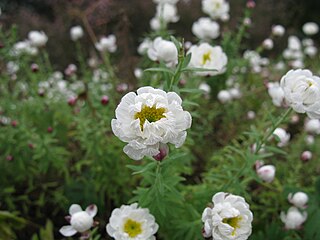
Rhodanthe anthemoides, commonly known as chamomile sunray, is a flowering plant in the family Asteraceae. It is a small, perennial shrub with greyish-green leaves, white papery flowers, yellow centre and is endemic to Australia.
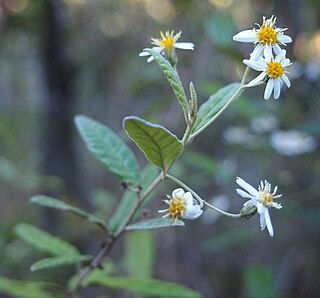
Olearia canescens is a species of flowering plant in the family Asteraceae and is endemic to eastern Australia. It is a shrub with scattered elliptic or egg-shaped leaves, and white and yellow, daisy-like inflorescences.

Olearia myrsinoides, commonly known as silky daisy-bush or blush daisy bush, is a species of flowering plant in the family Asteraceae and is endemic to south-eastern Australia. It is a spreading shrub with hairy branchlets, egg-shaped to elliptic leaves with toothed edges, and white and yellow or mauve, daisy-like inflorescences.
Calotis cymbacantha, the showy burr daisy, is a species of Calotis native to the arid areas of Australia. It is a perennial herb that grows between 10 and 40 cm tall. It has hairy erect stems which are woody at the base and produces yellow flowers.
Calotis pubescens is a species of daisy endemic to Australia and found in New South Wales and Victoria.

Helichrysum calvertianum is a species of flowering plant in the family Asteraceae. It is a small subshrub with small crowded leaves and single white daisy-like flowers. It is endemic to the Southern Highlands in New South Wales.

Calotis cuneifolia, the purple burr-daisy, is a species of daisy found in many parts of eastern and central Australia. A small herbaceous plant to 60 centimetres tall. Its leaves are simple and alternate in arrangement. Blue or purple flowers form at any time of year, but mostly seen in spring. The type specimen was collected by Allan Cunningham on the banks of the Lachlan River in 1817. The specific epithet "cuneifolia" refers to the wedged shape leaves.

Calotis hispidula, commonly known as the Bogan flea or bindi eye, is a hairy species of daisy found in many parts of mainland Australia. It is a small herbaceous plant growing up to 10 centimetres tall, with white flowers that are often seen in the winter months. The specific epithet hispidula refers to the plant's covering of stiff hairs.

Calotis lappulacea, commonly known as the yellow burr-daisy, is a flowering plant in the family Asteraceae found in many parts of mainland Australia. It is a small, perennial herb with yellow globular flower-heads.

Olearia flocktoniae, commonly known as Dorrigo daisy bush, is a species of flowering plant in the family Asteraceae and is endemic to a restricted area of New South Wales. It is a shrub with crowded, linear leaves, and white and yellow, daisy-like inflorescences.
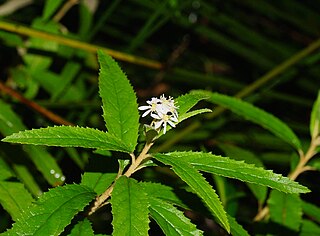
Olearia heterocarpa, commonly known as Nightcap daisy bush, is a species of flowering plant in the family Asteraceae and is endemic to eastern Australia. It is a shrub with narrowly elliptic or lance-shaped leaves with toothed edges, and white and yellow, daisy-like inflorescences.


















